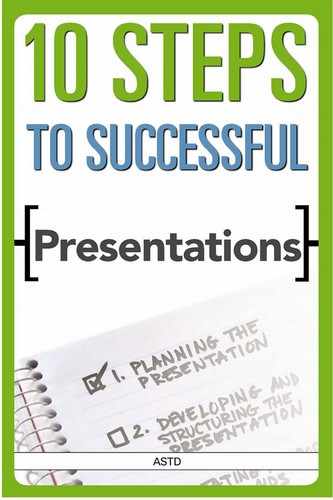INTRODUCTION
Standing in the spotlight to effectively communicate information that an audience needs or wants can be a truly scary experience—no matter what your level of experience of presenting in front of an audience. Whether you are a guest speaker presenting on a topic that someone else chose or presenting data to C-level managers, the basics to get you started in structuring and presenting the information are the same.
The business acumen expected of today’s business professionals includes effective communication and presentation skills. Without these skills, career goals and aspirations may be hindered. This book, 10 Steps to Successful Presentations, provides a framework you can use to create an effective presentation in a short time-frame. The tips and examples provided in each chapter will help to guide you through this process whether the presentation is for a large-or small-group setting.
Use the key steps in this book as needed. For example, if you have been asked to give an existing presentation; you can focus on steps 4 through 10. Or, if you have been asked to select and present on a topic in which you are starting with a completely blank slate—perhaps how the marketing strategy is poised to support new product revenue goals—then it might be most appropriate to start with step one and work through all of the steps systematically.
10 Steps to Successful Presentations provides proven techniques and tips for creating and delivering a presentation. In particular, this book will show you how to
- conduct an audience analysis
- plan the presentation outline and develop the content
- select visual aids to support and enhance your message
- demonstrate polished presentation skills
- plan and manage the presentation-room setup
- use facilitation techniques to engage the audience
- rehearse and perfect your presentation delivery.
Structure of This Book
10 Steps to Successful Presentations will help you to quickly plan, develop, and deliver a successful, compelling presentation. Each section describes one of the 10 specific steps for accomplishing this goal. Here is an overview:
- Step 1: Know Your Audience and Purpose: The Five Ws and More—No matter how the opportunity to present landed on your calendar, the first step is always to conduct an audience analysis and to answer the following questions—who, what, where, when, and why—in order to develop the purpose of the presentation.
- Step 2: Develop and Structure your Presentation— whether you need to create a presentation from scratch or embellish and personalize an existing presentation, all successful presentations have five standard components that you need to address. This step outlines strategies for planning to meet and greet the audience, developing your opening, creating transitions to maintain the presentation flow, building the body content, and closing on a bang.
- Step 3: Create Appropriate Visual Aids—visual aids enable you to enhance your presentation with both high-and low-tech solutions. Not all visual aids are appropriate in all situations—so it is important to understand the plethora of visual aids available and how to determine which visual is most appropriate for your presentation purpose, audience, and environment. This step provides visual-aid guidelines to enhance your successful presentation and not just decorate it.
- Step 4: Make It Memorable—Add Pizzazz to a Presentation—with the key and supporting points of the presentation outlined, this step takes your presentation to the next level by adding elements to excite and engage your audience, including ideas for attention-grabbing openers and icebreakers; storytelling tips; appropriate use of humor; and building the content with text, graphs, tables, statistics, and other good stuff.
- Step 5: Make Sure the Venue and Environment Work in Your Favor—creating an environment that is well-suited to the presentation is not only important in keeping the audience from heading for the door, but sends the message that as a credible professional, you took the time to consider and set up the environment. This step describes the list of presentation room setup guidelines and tips.
- Step 6: Stop—Review Basic Communication Tech-niques—although there are many different ways to present, there are certain methods and skills that seem to work best in most situations. This step highlights the presentation styles and techniques of the most successful presenters, including verbal and nonverbal skills.
- Step 7: Build in Facilitation Techniques to Engage Your Audience—most presenters are involved at one point or another in facilitating a presentation, meaning they involve the audience in open sharing of thoughts, opinions, and ideas. Becoming a strong facilitator is a required skill for any presenter and consists of part art and part science. This step outlines the basics of facilitating discussions and how you can harness these skills for your presentations.
- Step 8: Practice, Practice, Practice—a key rule for any presenter is to know the material. Period. Rehearsing the delivery helps to put the icing on the cake. This step focuses on tips and techniques for rehearsing the presentation, practicing theatrics such as telling a joke or story, anticipating stumper questions, and planning your answers.
- Step 9: Pause and Refresh—Relax You’ll Do Fine— sweaty palms and performance butterflies can plague even the most seasoned presenters, so what techniques do the pros use to combat nervousness and harness that energy and anxiety so they work in your favor? This step provides techniques to reduce performance anxiety and build confidence before stepping on the podium.
- Step 10: Deliver a Flawless Presentation—No Matter What Happens—even presenters who are professional, prepared, and credible will experience some embarrassing moment during their presentation careers. How they plan for and handle those unexpected and potential disasters is what makes the difference between novices and seasoned professionals. This step focuses on how to create a backup plan to get your presentation back on track no matter what happens.
Review these 10 steps as often as needed to build and perfect your ability to create and deliver successful presentations.
